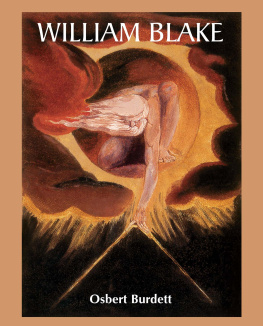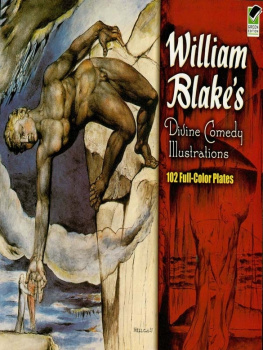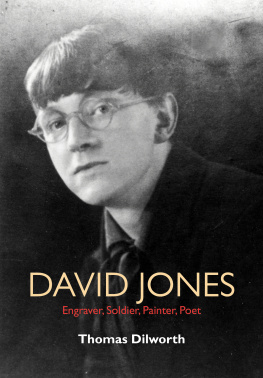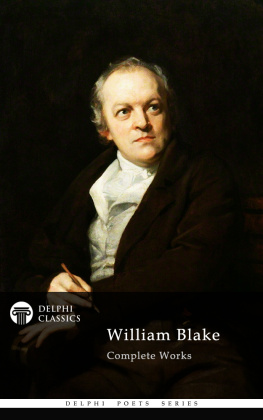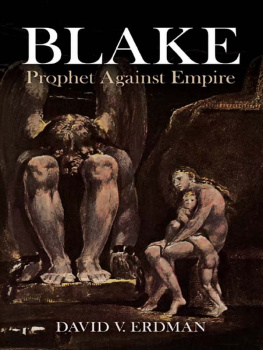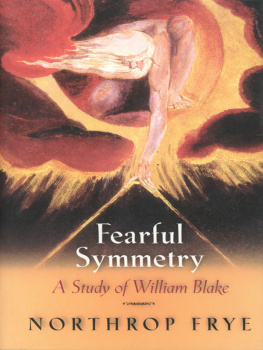Text: Osbert Burdett
Layout:
Baseline Co. Ltd
61A-63A Vo Van Tan Street
4 th Floor
District 3, Ho Chi Minh City
Vietnam
Confidential Concepts, worldwide, USA
Parkstone Press International, New York, USA
Image-Bar www.image-bar.com
ALL RIGHTS RESERVED
No parts of this publication may be reproduced or adapted without the permission of the copyright holder, throughout the world. Unless otherwise specified, copyright on the works reproduced lies with the respective photographers. Despite intensive research, it has not always been possible to establish copyright ownership. Where this is the case, we would appreciate notification.
ISBN: 978-1-78310-777-3
OSBERT BURDETT
WILLIAM BLAKE

Contents
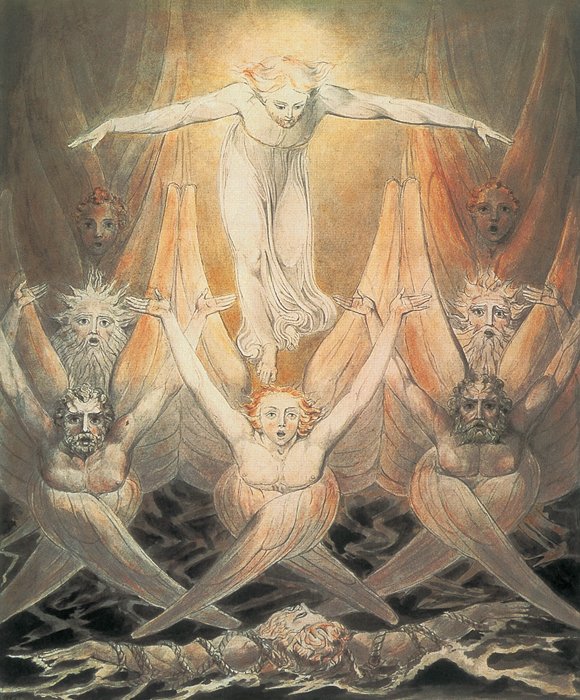
William Blake,David Delivered Out of Many Waters,
He Rode upon the Cherubim, c. 1805. Pen and ink and
watercolour on paper, 41.5 x 34.8 cm. Tate Gallery, London.
I. An Early Revelation
Boyhood, 1757-1771
In August 1827, confined to a couple of rooms in Fountain Court, an alley off the Strand, William Blakes death passed unnoticed, save by a small but gradually extending circle of friends. These were young artists who revered him and regarded themselves as his disciples. Blake aroused such interest in all the finer spirits who chanced to discover his character and his work, and his legacy quickly began to be communicated to the world. In 1828, 1830, and 1832, J. T. Smith, Allan Cunningham, and Frederic Tatham published their recollections on the poet and artist. In the great span of time that divides these enthusiasts from ourselves, the interest in Blake has grown substantially; now, there are volumes written about him, and libraries and museums all over the world devoted to housing his work. The canon of Blakes published writings is, even now, incomplete, and there is still a chance that some of his unrecovered works may emerge from their oblivion. We have come to see in him a prophet of the nineteenth century; the precursor, independently of Chatterton and the Lake Poets, of the Romantic Movement; the asserter of the principle of energy that is most valid in Nietzsche, whose mind and aphoristic manner curiously resembles Blakes; and the recoverer of the spirit of forgiveness. Blake was a poet, an artist, a seer, and an eccentric, whose later writings tantalise scholars in their eager search for intelligible and apprehensible truths. Blake will forever remain a poet and a puzzle; indeed, his reputation has been strengthened by its extraneous, non-artistic peculiarities.
Little is known of the history of his family. The parish registers, unearthed by Mr. Arthur Symons, reveal that William Blake was born on November 28, 1757, and that he was the third child of James and Catherine Blake, who were then living at 28 Broad Street, in the Golden Square neighbourhood of London. These registers further show that the future poet had two elder and two younger brothers, and that both the second and the fourth were christened John. Mr. Symons infers that the first John died before the age of five, and that his name was passed on to the fourth son, who, consequently, must be the John that Blake was to name the evil one. The fifth son is registered under the name of Richard, and was Blakes favourite brother. These five boys were followed by a little girl, Catherine Elizabeth.
On December 11, When William Blake was a fortnight old, his parents carried him to St. Jamess in Westminster, one of Christopher Wrens churches; here, with five other infants, Blake was baptised. Also at this time, the Italian sculptor Canova was born; Blakes future friends, the English painter and engraver Stothard and the sculptor and draughtsman Flaxman, were two years old; and the poet Thomas Chatterton was a little boy of five in Bristol. The atmosphere of Blakes childhood is preserved for us in an anecdote recorded by the diarist Crabb Robinson, which recounts how in the poets wife would remind him of his earliest vision. The first time you ever saw God, she would say when her husband was describing his peculiar faculty, was when you were four years old, and He put his head to the window and set you ascreaming. By the time Blake was a child of eight his visions were becoming habitual.
At that time Camberwell, Dulwich, Sydenham, and Newington Butts were still villages, and an active child who lived in Golden Square could quickly reach the open fields from London. On his return from one of these rambles, Blake ran home to tell his mother that he had seen the prophet Ezekiel under a tree. Though the good woman beat the boy for this assertion, and was doubtless scandalised that any of the prophets should be more real to her child than to herself, she seems to have felt compassion for him, for a year or so later when Blake came home from Peckham Rye with the news that he had seen a tree filled with angels, and his father was about to whip him for telling a fib, his mother interceded. On a third occasion, one bright morning in early summer, watching the haymakers at their work, the child saw angelic figures walking among them. How this was received at home we are not told, but it is evident that both parents were growing aware of the boys peculiarities and had begun to tolerate them. Thus his father refused to send him to school, having learned from experience that young Blake had a temper. There had probably been explosions at home; his parents, having abandoned the rod themselves, and hesitating to punish him, did not care to entrust him to strangers who might be less patient than their puzzled selves. The childs imagination and his impulsive expression of feeling were probably the worst faults they would find.
Blakes schooling, therefore, took place at home, where he learned to read and to write, but nothing more. His precocious poetry proves that these skills must have come easily to him. Moreover, with his active imagination, the sprawling environment, and the religious imagery of the conversation of his father and his fathers friends, it seems that Blake needed other companionship or a schoolmaster. If he had studied Greek and Latin in his boyhood, then the serious study of this literature and of the history that accompanies it might have given a valuable contrast to the exclusively religious interests in his home circle. Another mythology, another set of symbols, would thus have been presented to his mind. As things happened, the eccentric influence of Swedenborg was uncorrected by any other standard of comparison. Blakes father suspected no loss in this for the future of his boy since reading and writing were sufficient to equip him for helping his elder brother in the familys hosery shop, to which their father naturally destined the pair of them.
William, however, would draw and scribble on the backs of the customers bills and make sketches on the counter; it soon became a question whether he would make a good hosier and what to do with him if he would not. Allan Cunningham, who supplies these details, suggests the anxious discussions that went on, and the various sides taken by different members of the family, when he adds that the boys love of art was privately encouraged by his mother, and that Blake became an artist at the age of ten, and a poet at the age of twelve. The order in which these two talents developed is significant. The only formal instruction that Blake was to receive was inevitably designed for an artist, not for a man of letters. Of his twin dispositions toward art and poetry, the artistic was cultivated and the literary left alone. His observation was fed by watching nature and men in the fields and in the streets; his imagination, already stimulated by these, was nourished by looking at pictures; his intelligence was aroused by religious discussion, the sharing of opinions, and the entirely uncritical reading of books.
Next page
